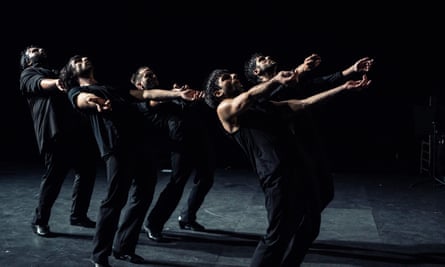Since the annual flamenco festival was first staged at Sadler’s Wells in 2003 the idea of what flamenco is has been stretched, ruptured and remoulded multiple times. One of its hits last year was Manuel Liñán’s ¡Viva! which saw Liñán and company kitted out in full female costumes, giving expression to their queer identities. (Liñán was nominated for both a National Dance award and an Olivier.)
Liñán is back this year, in an all-male gala show, and in a more low-key offering, Amor Amado Amén, which muses on love. It’s the result of a week’s residency at Sadler’s Wells, just five days in the studio with three collaborators: flamenco guitarist Francisco Vinuesa, multi-instrumentalist and psycho-sensory therapist Sabio Janiak and Croatian healer and spiritual coach Ivan Bavcevic. Not all conventional people to share the stage with.
Much of the work-in-progress still feels improvisatory, different worlds not quite meeting. Liñán experiments with using microphone taps and sharp breaths instead of contra-tiempo hand claps between the beats. Bavcevic intones, “Only desire keeps me alive” on repeat to a clubby beat. Janiak plays mournful cornet with Liñán dancing flirtatiously close. There are some beautiful moments, such as when two men walk simply together, smiling into each other’s eyes, but this is definitely still at the development stage. Things fall more easily into place when Liñán dances in intense conversation with Vinuesa’s guitar. On familiar ground, Liñán is neatly explosive, with the strong, sudden attack of a mousetrap, and when he gets sucked into the moment, so do we.
Over in Sadler’s Wells’ main house, another all-male offering, La Confluencia, from Rafael Estévez, Valeriano Paños and company sees more deeply engrossing rhythm and more underdeveloped theatricality. La Confluencia is inspired by the meeting of cultures that formed flamenco, from India to Europe, via Jewish and north African influences. But this is no travelogue, and everything’s woven into the mass of movement, alongside other magpied steps: a courtly bow, ballet’s arabesque and développé, contact partnering, a brief karate kick, some folk dance. At one point the men’s wiggling bums underline that there’s humour here, but it’s played with a straight face.
Thematically as the piece moves forward it’s hard to read, but the dancing is irresistible. Five men, all in black, prowling to the front of the stage, intensely eyeing the audience. Their footwork has clarity of rhythm, not just a stampede. There’s an economy to the performance, only what needs to move, moves, direct from A to B, but with style. Paños spins tightly, on an immovable axis, while Estévez’s hands are a flying blur, as if frantically whispering, or else he sits on a chair, facing off with warm-toned singer Francisco Blanco, just letting his feet do the talking.

As the piece progresses over 100 minutes, some of it starts to feel relentless, and the no-doubt deeply researched references are lost to all but the most expert viewer. But there are still bursts of brilliance, like Estévez’s racing torrent of spoken syllables, presumably the bols, or vocal percussion of north India, where flamenco is thought to have originated centuries ago, its roots still underpinning an ever-progressing art form.

